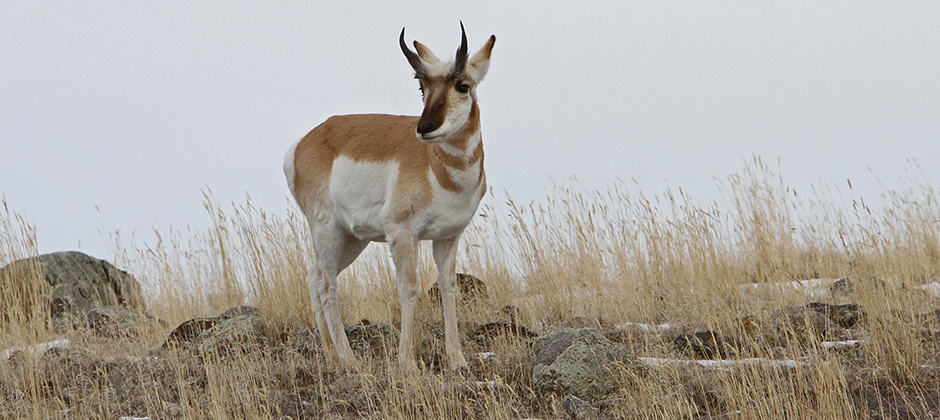Share this article
TWS2020: Pronghorn responses to wind turbines vary
Most studies on the effects of wind turbines on wildlife focus on bats and birds, but researchers wondered how pronghorn may be affected.
In a contributed oral presentation at the virtual Annual TWS Conference, TWS member Meghan Milligan, a research assistant with the U.S. Geological Survey, explains how she tried to tackle this question.
“Wind energy is the fasting growing source of electricity worldwide. It’s grown 23-fold in the last 20 years alone,” Milligan said in her presentation. But while past research has looked at the effects of things like oil and gas development on pronghorn (Antilocapra americana), no one had yet looked at the effects of this source of energy meant to reduce carbon emissions.
Milligan and her colleagues first looked at the possible differences between the different sources of energy.
Oil and gas drilling has different features, for one. It also has more humans around throughout production. Wind energy usually only has a human presence when wind turbines are being built.
Past research has shown ungulates experience negative effects from oil and gas development. Pronghorn response to oil and gas development is mixed, she said. “We don’t know, though, whether these consistent negative effects that we’ve seen for most ungulates will transfer over to wind energy development,” Milligan said.
In the Shirley Basin of south-central Wyoming, Milligan and her colleagues looked at wind energy development and pronghorn behavior between winter 2010 and spring 2012, and then again from March 2018 until now. These study periods gathered data from before, during and after wind farm construction. Milligan and her team looked at whether pronghorn were displaced by wind turbines, if their home range size increased with development, and their habitat selection and avoidance within their home ranges.
The results were not so straightforward. They found variable effects of wind energy on pronghorn in the summer. Some years they selected areas farther from turbines and some years closer. When they selected closer areas, they weren’t selecting for the turbines, Milligan said. Instead, the turbines were placed in high quality pronghorn habitat. “There was no reasonable alternative,” she said. “They were still forced to select that habitat.” Winter showed similar results.
As for home range size, they found that overall, summer home ranges were much smaller. But when there were harsh winters, home ranges were larger. “Pronghorn were forced to move due to harsh winter conditions in order to find less snow or more favorable temperatures,” she said. But home range size wasn’t influenced by turbines.
The team did find that when they looked at individual pronghorns, those in close range to the turbines — about 50 to 70 kilometers away — did not respond during construction, but in the post-construction phase, they tended to avoid the turbines.
“Overall, the takeaway from the research is there were inconsistent and variable effects of wind energy on pronghorn,” she said. “They varied in both direction and significance from year to year and season to season, which was driven by high individual variability.”
More significant effects may await, though, as development continues, Milligan said. “We may at some point reach a critical threshold where we do begin to see these effects of development,” she said. “That’s important to keep in mind as we continue to develop these important habitats for these animals.”
Visit office hours for this contributed paper on Wednesday, Sept. 30 from 3 p.m. to 4 p.m. to learn more and ask questions. A video recording of the presentation will be available starting Monday, Sept. 28.
Header Image: Overall, pronghorns are not displaced by wind turbines, researchers found. Credit: Jim Peaco








